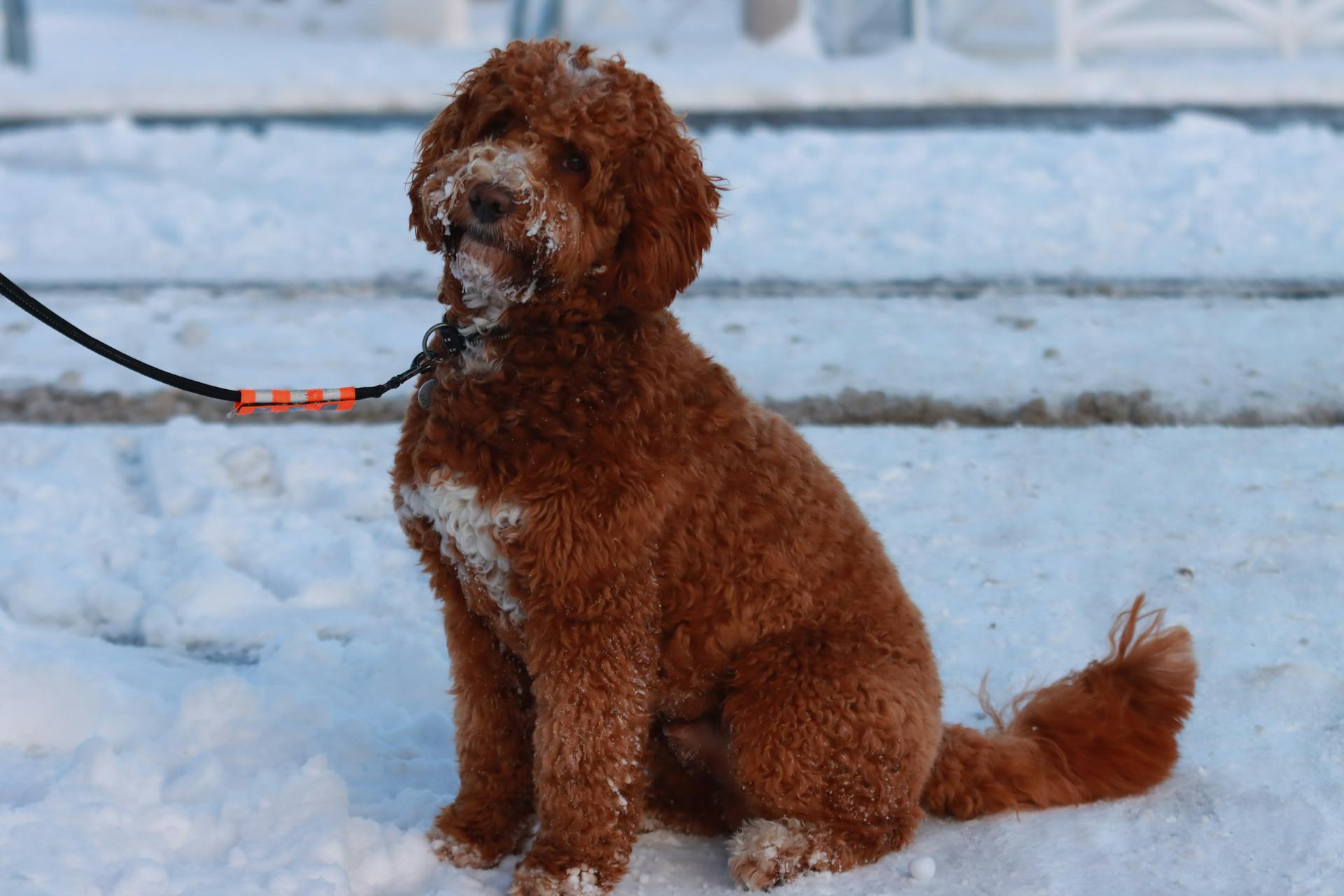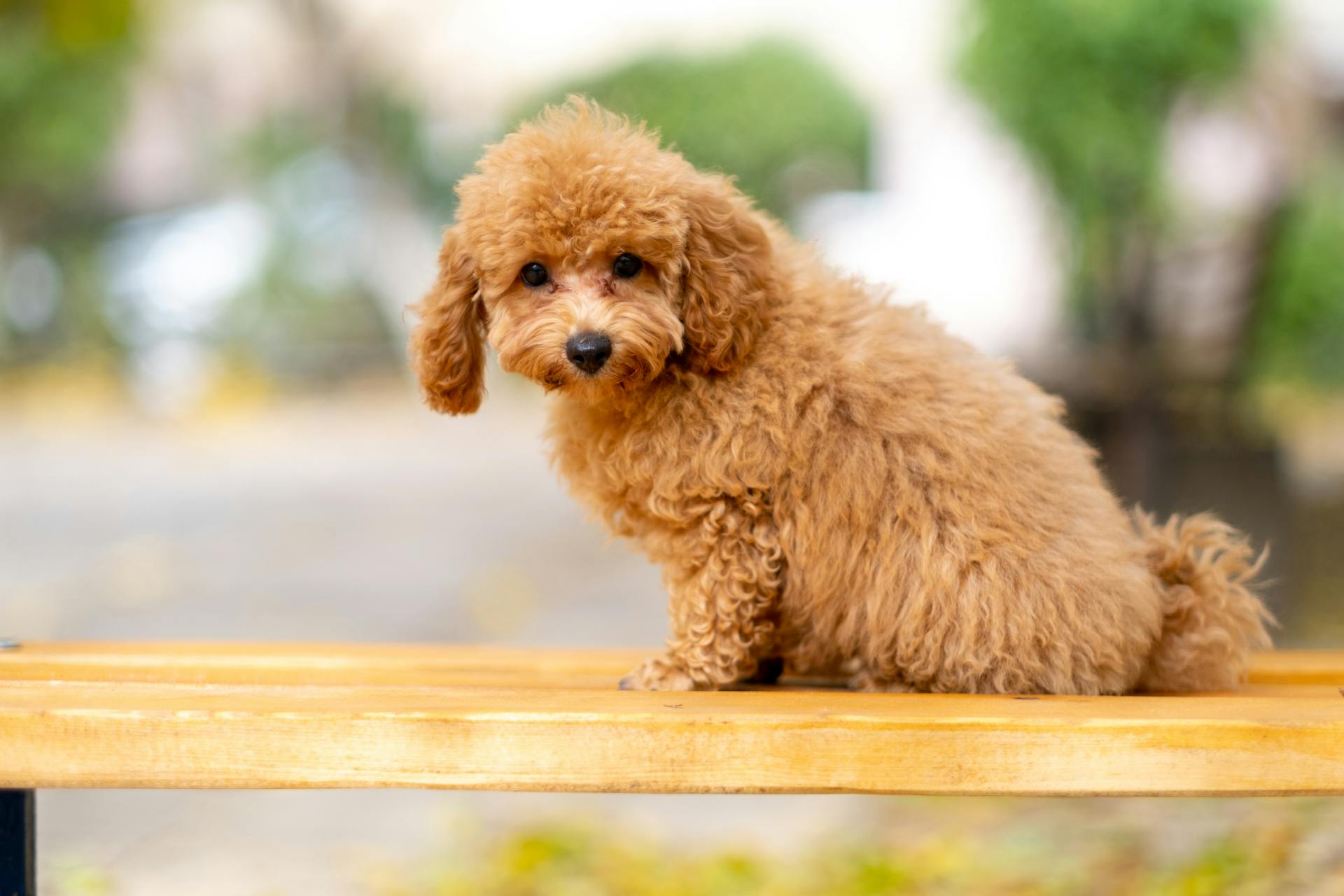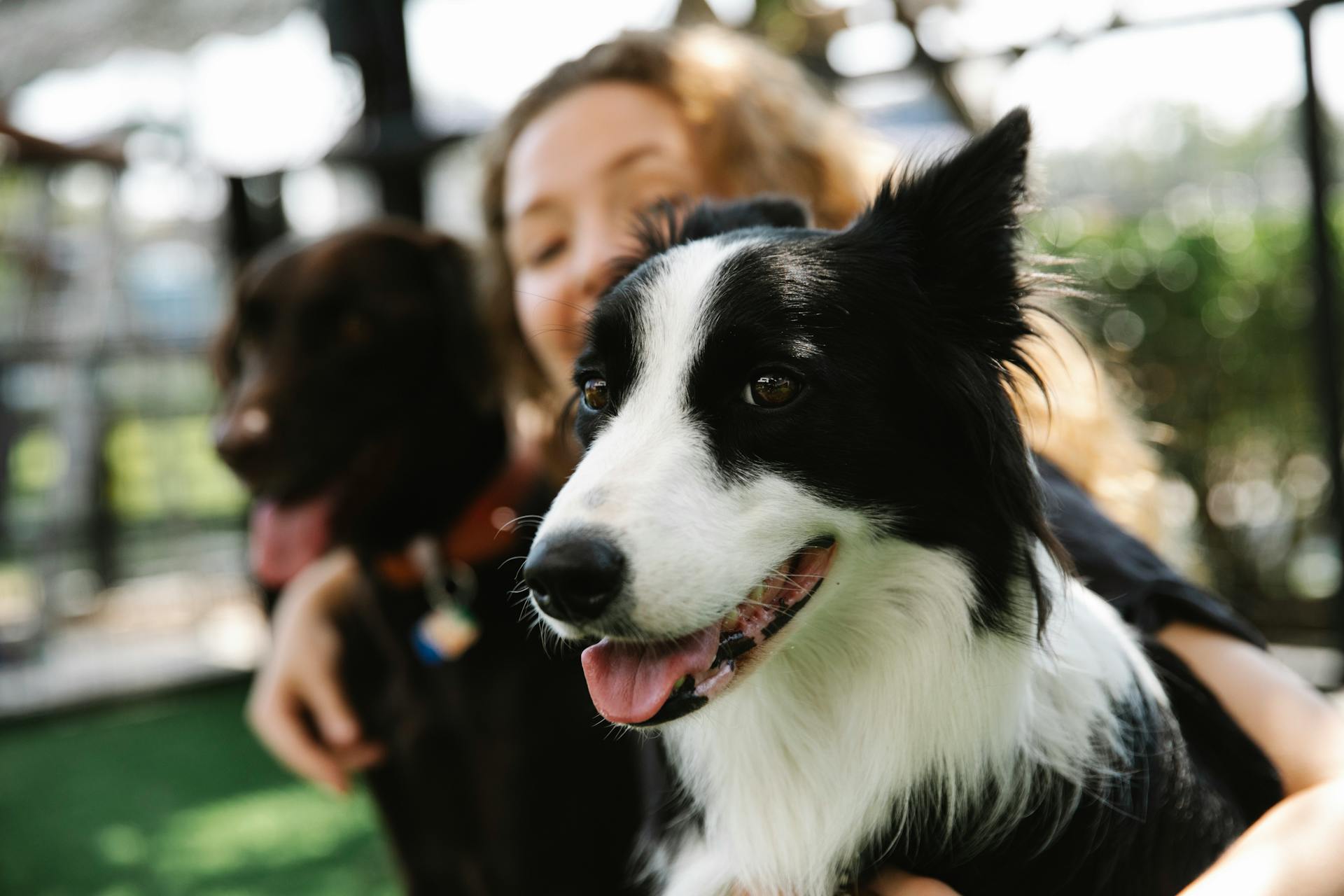
Mini Labradoodles are often touted as a solution for families with allergy issues, but are they truly hypoallergenic?
The Mini Labradoodle's low-shedding coat is a key factor in its hypoallergenic reputation. This is because they inherit the Poodle's low-shedding trait, which reduces the amount of dander released into the air.
For many people, this means that Mini Labradoodles can be a good option for those who want to bring a dog into their home without exacerbating allergy symptoms. However, it's essential to note that no dog is 100% hypoallergenic, and individual reactions may vary.
Mini Labradoodles still produce some dander, but their low-shedding coat means it's significantly less than other breeds.
Here's an interesting read: Low Energy Hypoallergenic Dogs
What Are Mini Labradoodles?
Mini Labradoodles are a cross between a Labrador Retriever and a Miniature Poodle, often bred to create a low-shedding, hypoallergenic companion dog.
They typically weigh between 15-30 pounds and stand between 14-18 inches tall, making them a great size for many families.
Mini Labradoodles are known for their friendly and outgoing personalities, inherited from their Labrador Retriever parents.
Their intelligence and trainability make them a popular choice for first-time dog owners and experienced pet parents alike.
Mini Labradoodles often require regular grooming to prevent matting and tangling of their fur, which can be a significant time commitment for owners.
Are Mini Labradoodles Hypoallergenic?
Mini Labradoodles are often considered a popular choice for people with allergies, but are they truly hypoallergenic? The answer is a bit more complicated than a simple yes or no.
The term "hypoallergenic" refers to breeds that are less likely to cause an allergic reaction in people with dog-allergic sensitivities. However, no dog is 100% hypoallergenic, and individual genetics can play a big role in determining whether a dog will trigger allergies.
Labradoodles, including mini Labradoodles, can cause more severe allergic reactions in some people, especially those with asthma and hypersensitivity. This is because they shed less than their Labrador parent but still have full and thick coats that can release allergens.
However, some Labradoodle breeds are considered more likely to be hypoallergenic than others. For example, F2 hybrid Labradoodles, which are a mix of two F1 hybrids, often don't shed at all, making them a good choice for people with allergies.
Here's a breakdown of the different types of Labradoodles and their hypoallergenic potential:
Keep in mind that even with these breeds, there's still a chance that you could suffer allergic reactions from your pet's occasional dander. To minimize the risk, you can take steps to reduce the amount of dander from both your pet and your home, such as using HEPA filters and regularly cleaning your home.
Living with Allergies and Mini Labradoodles
Mini Labradoodles are often considered a good option for people with allergies, but it's essential to understand that they may still cause allergic reactions in some individuals.
The truth is, even the most allergy-friendly Labradoodle sheds more frequently than a Poodle, which means there's still a chance you could suffer allergic reactions from your pet's occasional dander.
Reducing dander is crucial for minimizing allergic reactions. You can take steps to reduce dander from your pet and your home, such as using HEPA filters, as mentioned in the article.
While some people may not react to their Labradoodle, others may still experience allergic reactions. It's not a 100% guarantee that someone with extreme allergies or asthma will never react to a doodle or any kind of dog.
Fortunately, there are many resources available to help you deal with pet allergies. For example, you can check out the tips from Filtrete to combat pet allergies.
Here are some key points to consider:
It's also worth noting that some experts, like Dr. Clifford W. Bassett, have proven that non-shedding dog breeds are much more likely to be hypoallergenic. This means that if you're looking for a breed that's less likely to cause allergic reactions, you may want to consider a Poodle or Poodle-cross.
Understanding Hypoallergenic Dog Breeds
Hypoallergenic dog breeds are those that are less likely to cause an allergic reaction in people with dog-allergic sensitivities.
The term "hypoallergenic" was originally used in 1953 to describe cosmetics that were less likely to cause allergic reactions. It's still used today in the cosmetics world, and is also used for dogs that are less likely to cause allergic reactions.
A dog is considered hypoallergenic when it produces fewer allergens in its skin secretions, urine, and saliva. However, no dog is 100% hypoallergenic, and people with hypersensitivities may still experience an allergic reaction.
Labradoodles, in particular, are considered hypoallergenic because they were bred to be that way. Wally Conron, a guide dog trainer, bred the first Labradoodle to create a hypoallergenic guide dog.
Here's a breakdown of the different generations of Labradoodles and their likelihood of being hypoallergenic:
While no dogs are 100% hypoallergenic, Labradoodles are a good option for people with allergies. They have a lower shedding coat than many other breeds, which reduces the amount of allergens that are released into the environment.
It's worth noting that even hypoallergenic dogs can still cause allergic reactions in some people. If you're allergic to dogs and are considering getting a Labradoodle, it's a good idea to spend some time with the breed before committing to ownership to see if you have a reaction.
Regular Grooming
Regular grooming is essential for mini Labradoodles, especially if you or a family member suffers from allergies. Regular grooming can make your mini Labradoodle more hypoallergenic by getting rid of dander, dust, and pollen, which are the main causes of allergic reactions to pet hair.
Daily brushing is a must, as it allows you to reduce the amount of shedding and prevents matted coats. Brushing your mini Labradoodle's coat outwards from the skin using a slicker brush is the way to go. If the hair is too long, use a wide-toothed comb to brush the hair in an outward direction.
Bathing your mini Labradoodle with anti-allergenic shampoo at least once a month is also recommended. This will help clean your pup's skin properly and remove any dander or old skin cells. Remember, grooming exposes you to potential allergens, so it's a good idea to delegate that task to someone who doesn't suffer from pet allergies.
Here's a quick rundown of the grooming tasks you should perform regularly:
- Brush daily using a slicker brush or wide-toothed comb
- Bathe at least once a month with anti-allergenic shampoo
- Trim hair around eyes, between eyes, and at the bridge of the nose using battery-operated trimmers or blunt scissors
Researching and Choosing a Mini Labradoodle
To determine if a mini Labradoodle is hypoallergenic, you need to understand their coat types, which are influenced by their Poodle parent.
Labradoodles can be classified into generations, including F1, F1B, and F2, which can help you identify their coat characteristics.
If you're looking for a mini Labradoodle with an allergy-friendly coat, you'll want to focus on those with a Poodle-like coat, which is more common in F1B Labradoodles.
F1b (2 Generation)
An F1b Labradoodle results from breeding a first-generation Labradoodle with a Poodle, increasing the chances of the offspring inheriting a Poodle coat by 75%. This makes F1b Labradoodles a great option for people who are severely allergic to pet dander.
You need to confirm that your F1b Labradoodle was bred in this way, as some breeders may mate two first-generation Labradoodles and offer their offspring as 2 generation Labradoodles.
F1b Labradoodles are more likely to have a Poodle coat, which is generally considered to be a low-shedding coat. This means they may be a better choice for people with allergies.
Breeder Research
When searching for a mini Labradoodle breeder, check breed registries like the American Kennel Club for a list of reputable breeders.
You can also get referrals from friends or family who have bought a dog from a breeder and had a positive experience.
Labradoodles are prone to health issues like hip dysplasia, Addison's disease, von Willebrand's disease, and progressive retinal atrophy.
Ask the breeder for health certifications to ensure the pup is healthy and has had necessary tests.
Word-of-mouth referrals are often better than online reviews, so don't rely solely on websites or social media.
Sources
- https://www.crockettdoodles.com/hypoallergenic/
- https://www.hepper.com/are-labradoodles-hypoallergenic/
- https://www.labradortraininghq.com/labrador-breed-information/do-labradoodles-shed/
- https://www.dogster.com/dog-breeds/is-a-labradoodle-hypoallergenic
- https://www.prideandprejudoodles.com/different-types-of-labradoodle-puppy-coats/
Featured Images: pexels.com


